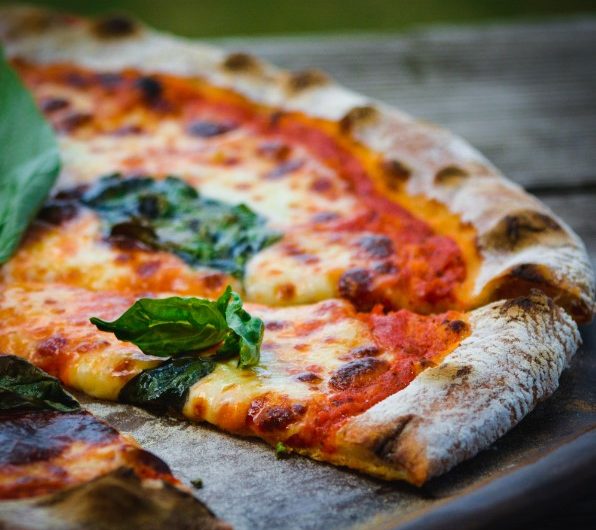Pizza is undoubtedly one of the most beloved and versatile foods around the world. It’s a canvas for endless creativity and flavors, and there’s a pizza for every taste bud. Among the many pizza chains out there, Round Table Pizza stands out for its commitment to quality ingredients and exceptional taste. And what lies at the heart of any great pizza? The dough, of course!

In this blog post, we’re going to delve into the world of Round Table Pizza and share with you the secret behind their iconic pizza dough. Whether you’re a die-hard Round Table Pizza fan or simply looking to recreate that mouthwatering pizza experience at home, this article is your guide to mastering the Pizza dough recipe.
A Brief History of Round Table Pizza
Before we jump into the dough recipe, it’s essential to understand the background and ethos of Round Table Pizza. The company was founded in 1959 in Menlo Park, California, by William R. Larson. From its humble beginnings, Round Table Pizza has grown into a beloved chain known for its commitment to quality and innovation.

Round Table Pizza prides itself on using fresh, high-quality ingredients and their proprietary pizza dough recipe that has remained a closely guarded secret for decades. The signature crispy and slightly sweet crust has captured the hearts of pizza enthusiasts for generations.
So, let’s get started with our journey to recreate the magic of Round Table Pizza’s dough in your very own kitchen.
The Essentials of Round Table Pizza Dough
The key to replicating the iconic Round Table Pizza dough lies in the ingredients and the precise method of preparation. Here’s what you’ll need:
Round Table Pizza
Course: Uncategorized4
servings30
minutes40
minutes300
kcalIngredients
All-Purpose Flour: You’ll need approximately 4 cups of all-purpose flour.
Water: About 1 and 1/4 cups of lukewarm water.
Sugar: 1 teaspoon of sugar to help activate the yeast.
Yeast: 2 and 1/4 teaspoons of active dry yeast or 1 packet.
Salt: 1 teaspoon of salt for flavor.
Olive Oil: 2 tablespoons of olive oil to enrich the dough and add a subtle depth of flavor.
Directions
- Proof the Yeast: In a small bowl, combine the lukewarm water, sugar, and yeast. Stir gently and let it sit for about 5-10 minutes until it becomes frothy. This step is crucial, as it activates the yeast and ensures your dough will rise properly.
- Mix the Dry Ingredients: In a separate large bowl, combine the all-purpose flour and salt. This is your dry mix, and it’s essential to ensure the salt is evenly distributed throughout the flour.
- Combine Wet and Dry Ingredients: Make a well in the center of the dry mixture and pour in the yeast mixture along with the olive oil. Slowly incorporate the dry ingredients into the wet, stirring with a wooden spoon or your hands until a dough forms.
- Knead the Dough: Once the dough starts to come together, turn it out onto a lightly floured surface. Knead it for about 5-7 minutes until it’s smooth and elastic. If the dough is too sticky, add a little more flour, but be mindful not to add too much.
- First Rise: Place the dough in a lightly oiled bowl and cover it with a damp cloth. Allow it to rise for approximately 1-2 hours or until it has doubled in size. This step is where the magic happens, as the dough develops its flavor and texture.
- Divide and Shape: After the first rise, punch down the dough and divide it into the desired number of pizza crusts. For Round Table Pizza’s signature style, you can create one large pizza or multiple smaller ones. Shape the dough into rounds and let them rest for 15-20 minutes.
- Second Rise: While the dough is resting, preheat your oven to 475°F (245°C). This high temperature will help achieve that crispy crust that Round Table Pizza is known for. If you have a pizza stone, place it in the oven during the preheat.
- Roll Out the Dough: Roll out each dough portion into a circle, ensuring they’re not too thin. Round Table Pizza’s crust has a slightly thick and chewy texture, so aim for a thickness that suits your preference.
- Assemble and Bake: Now comes the fun part! Add your favorite sauce, cheese, and toppings to your pizza crusts. Be sure to use high-quality ingredients for an authentic taste. Once your pizza is ready, place it in the preheated oven on a pizza stone or a baking sheet and bake for about 12-15 minutes, or until the crust is golden brown and the cheese is bubbly and slightly browned.
Notes
- Enjoy!
- Take your homemade Round Table Pizza out of the oven and let it cool for a minute or two. Slice it, serve it, and savor the delicious flavors that you’ve recreated right in your own kitchen.
The Secret to Round Table Pizza’s Dough
The secret to Round Table Pizza’s exceptional dough is not just in the ingredients but also in the technique. Here are some key tips to perfecting your Round Table Pizza dough:

1. Lukewarm Water: Make sure the water you use to proof the yeast is lukewarm, around 110°F (43°C). This temperature encourages yeast activation without killing it.
2. Patient Rising: Letting the dough rise for a sufficient amount of time is crucial. This not only allows the yeast to work its magic but also develops the dough’s flavor and texture. Don’t rush this step.
3. Olive Oil Enrichment: The addition of olive oil is what gives Round Table Pizza’s dough a subtle depth of flavor. It also contributes to the crispy crust when baked at high temperatures.
4. High-Temperature Baking: Preheat your oven to 475°F (245°C) to achieve the signature crispy texture of Round Table Pizza’s crust. If you have a pizza stone, use it for even better results.
5. Quality Ingredients: Choose high-quality ingredients for your sauce, cheese, and toppings. Round Table Pizza’s commitment to quality ingredients is a significant part of its success.
Customizing Your Pizza
One of the delightful aspects of pizza is the ability to personalize it to your taste. Round Table Pizza offers a variety of toppings and flavors, and you can do the same at home. Whether you prefer a classic pepperoni and cheese pizza, a veggie-loaded delight, or something entirely unique, the Pizza dough provides the perfect canvas for your culinary creativity.

Here are some topping ideas to get you started:
- Pepperoni Lover’s Pizza: Generous layers of pepperoni combined with mozzarella and a sprinkling of dried oregano.
- Hawaiian Paradise: Ham, pineapple chunks, and a blend of mozzarella and cheddar cheeses.
- Veggie Supreme: Load up your pizza with colorful bell peppers, black olives, red onions, mushrooms, and fresh basil.
- Meat Extravaganza: Combine various meats like sausage, bacon, and ground beef with a mix of cheeses for a hearty, protein-packed pizza.
- Margarita Pizza: A simple yet classic choice featuring tomato sauce, fresh mozzarella, basil leaves, and a drizzle of olive oil.
- BBQ Chicken Pizza: Swap out traditional tomato sauce for barbecue sauce, add cooked chicken, red onions, and cheddar cheese.
The possibilities are endless, so don’t be afraid to experiment with different ingredients and flavor combinations. Part of the fun of making pizza at home is creating a unique culinary masterpiece.
Conclusion
Round Table Pizza has been serving delicious pizzas for decades, and now you have the chance to recreate their signature crust in your own kitchen. With a few key ingredients and some patience, you can craft a pizza that rivals those served in their restaurants.

Whether you’re a lifelong fan of Round Table Pizza or you’re just discovering the magic of their dough, this recipe offers a taste of pizza perfection. So gather your ingredients, roll up your sleeves, and get ready to savor a slice of pizza heaven right at home. Enjoy the art of making your very own Round Table Pizza with this cherished recipe, and remember, there’s no limit to the toppings and flavors you can explore. Happy baking!




